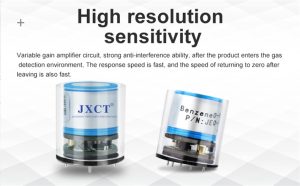Industrial emissions control is a crucial aspect of environmental protection, and gas sensors play a significant role in this process. This article explores the potential of gas sensors in industrial emissions control, including their ability to detect and monitor harmful gases, improve process efficiency, and contribute to environmental compliance.

Introduction
Industrial emissions are a significant source of air pollution, and their control is crucial for environmental protection. Gas sensors are an integral part of this process, as they provide accurate and real-time data on the presence of harmful gases in the atmosphere. By employing gas sensors in industrial emissions control, it is possible to ensure the efficient operation of processes, protect worker health, and comply with environmental regulations.
-
Detection and Monitoring of Harmful Gases
Gas sensors have the ability to detect and monitor harmful gases in the atmosphere, such as volatile organic compounds (VOCs), nitrogen oxides (NOx), sulfur oxides (SOx), and carbon monoxide (CO). These sensors can continuously monitor the air quality in the vicinity of industrial processes and provide early warning of potential pollution events. This information is crucial for decision makers to take appropriate measures to mitigate the impact of harmful gases on the environment and public health.
-
Improving Process Efficiency
Gas sensors can also contribute to improving process efficiency in industrial emissions control. By monitoring the gas composition in the exhaust stream, sensors can provide feedback on the performance of emission control equipment. This information allows operators to adjust process parameters and operating conditions to optimize the efficiency of emission reduction equipment. As a result, gas sensors contribute to reducing energy consumption, waste production, and operating costs while maintaining high process performance.
-
Environmental Compliance
Gas sensors play a crucial role in environmental compliance by providing accurate data on industrial emissions. Regulatory agencies require companies to monitor and report their emissions, and gas sensors provide an effective means to collect this data. By using gas sensors, companies can ensure accurate measurement of their emissions, comply with environmental regulations, and demonstrate their commitment to environmental protection. This compliance can also enhance a company's reputation and improve its standing with stakeholders.
-
Integration with Automation Systems
Gas sensors can be integrated with automation systems to enhance industrial emissions control. By connecting gas sensors to control systems, operators can monitor and adjust process parameters remotely. This integration allows for more efficient operation of emission reduction equipment, reduces the need for manual intervention, and improves overall process efficiency.
-
Future Developments
The future of gas sensors in industrial emissions control holds significant promise. Advances in sensor technology, such as the development of low-cost, high-sensitivity sensors, will enable more widespread use of gas sensors in smaller-scale applications. In addition, advances in data analytics and machine learning algorithms will enable more accurate prediction and modeling of emissions patterns, leading to more effective emission reduction strategies.

Conclusion
Gas sensors hold significant potential in industrial emissions control, providing accurate detection and monitoring of harmful gases, improving process efficiency, and contributing to environmental compliance. By integrating gas sensors into industrial processes, companies can ensure efficient operation, protect worker health, and comply with environmental regulations. The future of gas sensors holds promise for further advancements in sensor technology and data analytics that will enable more effective control of industrial emissions and contribute to a healthier environment.
 : +86 155 8830 2704
: +86 155 8830 2704 : jxdziot@gmail.com
: jxdziot@gmail.com
